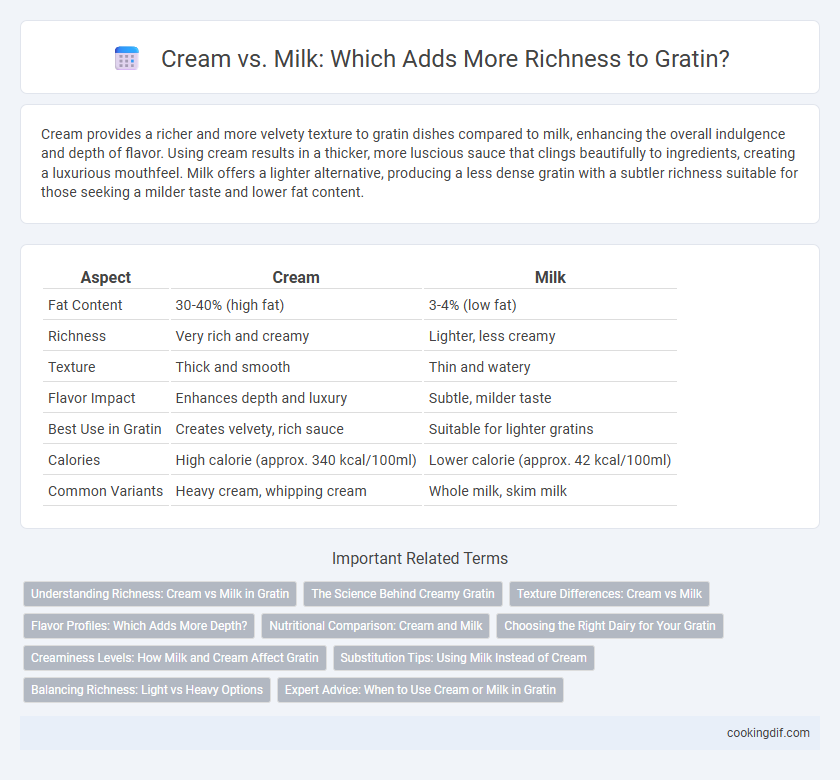Cream provides a richer and more velvety texture to gratin dishes compared to milk, enhancing the overall indulgence and depth of flavor. Using cream results in a thicker, more luscious sauce that clings beautifully to ingredients, creating a luxurious mouthfeel. Milk offers a lighter alternative, producing a less dense gratin with a subtler richness suitable for those seeking a milder taste and lower fat content.
Table of Comparison
| Aspect | Cream | Milk |
|---|---|---|
| Fat Content | 30-40% (high fat) | 3-4% (low fat) |
| Richness | Very rich and creamy | Lighter, less creamy |
| Texture | Thick and smooth | Thin and watery |
| Flavor Impact | Enhances depth and luxury | Subtle, milder taste |
| Best Use in Gratin | Creates velvety, rich sauce | Suitable for lighter gratins |
| Calories | High calorie (approx. 340 kcal/100ml) | Lower calorie (approx. 42 kcal/100ml) |
| Common Variants | Heavy cream, whipping cream | Whole milk, skim milk |
Understanding Richness: Cream vs Milk in Gratin
Cream enhances gratin's richness by adding a higher fat content, resulting in a velvety, luxurious texture and deeper flavor complexity. Milk, with lower fat levels, produces a lighter, less dense gratin, allowing other ingredients' flavors to shine through without overwhelming the dish. Choosing cream versus milk directly impacts the gratin's mouthfeel and richness, making cream ideal for indulgent recipes and milk preferred for lighter, balanced results.
The Science Behind Creamy Gratin
Cream enhances gratin richness due to its higher fat content, which emulsifies during baking, creating a luscious, velvety texture. Milk, with lower fat levels, results in a lighter, less creamy consistency as it lacks sufficient fat to form the same smooth, cohesive sauce. The science behind creamy gratin involves fat molecules stabilizing emulsions and inhibiting protein coagulation, which prevents curdling and ensures a silky finish.
Texture Differences: Cream vs Milk
Cream in gratin dishes creates a richer, silkier texture due to its higher fat content, resulting in a velvety mouthfeel and thicker consistency. Milk produces a lighter, less dense texture, allowing other ingredients like cheese and breadcrumbs to stand out more prominently. Choosing cream enhances the luxurious, smooth layering typical of classic gratins, while milk offers a subtler, more delicate finish.
Flavor Profiles: Which Adds More Depth?
Cream contributes a richer, velvety texture and intensifies the buttery, slightly sweet flavor in a gratin, enhancing its overall depth. Milk offers a lighter, more neutral base that allows other ingredients like cheese and herbs to stand out without overwhelming the palate. Choosing cream results in a fuller-bodied dish with a luxurious mouthfeel, while milk provides subtlety and balance to the gratin's flavor profile.
Nutritional Comparison: Cream and Milk
Cream contains significantly higher fat content, typically around 30-40%, compared to milk's 3-4%, contributing to a richer texture and higher calorie count in gratin dishes. Milk provides more protein and calcium per serving, making it a lighter option with added nutritional benefits but less creaminess. The choice between cream and milk directly influences the gratin's mouthfeel, calorie density, and nutrient profile, with cream enhancing richness and milk promoting a more balanced nutritional intake.
Choosing the Right Dairy for Your Gratin
Choosing the right dairy for your gratin significantly impacts its richness and texture. Heavy cream offers a luxurious, velvety consistency with higher fat content, creating a richly indulgent dish. Milk provides a lighter option, resulting in a creamier but less dense gratin, ideal for those seeking subtle richness without overwhelming heaviness.
Creaminess Levels: How Milk and Cream Affect Gratin
Cream provides a higher fat content compared to milk, resulting in a richer and more luscious gratin texture. Milk yields a lighter, less dense dish but still adds moisture and mild creaminess suitable for those seeking a subtle taste. Choosing cream enhances the gratin's velvety mouthfeel and golden crust, while milk offers a balanced and delicate finish.
Substitution Tips: Using Milk Instead of Cream
Using milk instead of cream in gratin recipes reduces richness but maintains a lighter texture, suitable for those seeking lower fat options. To enhance creaminess when substituting milk, incorporate a small amount of butter or a thickening agent such as flour or cornstarch. Adjust cooking time and temperature to prevent milk from curdling, ensuring a smooth, velvety gratin sauce.
Balancing Richness: Light vs Heavy Options
Choosing cream over milk in a gratin recipe significantly enhances richness due to cream's higher fat content, creating a luxuriously smooth and velvety texture. Milk offers a lighter alternative that yields a more delicate dish with less heaviness, making it ideal for balancing flavor without overwhelming the palate. For a perfect gratin, blending cream and milk can achieve an optimal balance, enriching the dish while maintaining a subtle, creamy consistency.
Expert Advice: When to Use Cream or Milk in Gratin
Expert chefs recommend using cream in gratin dishes when aiming for a luxurious, rich texture and deep flavor, as its higher fat content creates a velvety sauce that enhances the dish's indulgence. Milk is preferable for lighter gratins or when balancing richness with a more delicate taste and lower calorie content, providing sufficient moisture without overwhelming the other ingredients. The choice between cream and milk directly influences the gratin's mouthfeel and overall richness, making the ingredient selection crucial depending on the desired culinary outcome.
Cream vs Milk for richness Infographic

 cookingdif.com
cookingdif.com